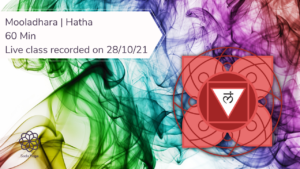A balanced chakra system is said to give rise to optimal physical and mental health and well-being. Use this ‘how-to’ guide below to learn about poses that balance each of the chakras. For more detail about the chakra system, what they do, and how they relate to the body and mind, check out my blog Chakras.
MOOLADHARA – ROOT CHAKRA
Malasana – Garland Pose

This pose has a whole host of wonderful benefits, including balancing the first chakra, Mooladhara. It stretches the ankles, hips, knees, spine, shoulders arms, and neck while improving flexibility in the hips. Due to this pose tapping into our downward flowing energy, malasana really helps calm the mind and help us feel grounded. With the added extra of aiding digestion.
How to:
- From Tadasana, step the feet to wider than hip-distance apart.
- Bring the hands into prayer pose at the heart center.
- Keep the spine long.
- Start to bend the knees and sink the hips low, allow the heels to lift when they need to – ( if you struggle to get the heels down and feel off-balance, place blocks under the heels or roll up your mat for support).
- When you’re as low as you can get, lift the chest away from the pelvis.
- Elbows on the insides of the knees, use and press of the elbows the elevate the spine longer.
- Breath 5-10 rounds. When ready to come out, slowly straighten the legs and rise up.
- Step the feet back to Tadasana.
- Release the hands down.

More poses to balance Mooladhara Chakra: Tadasana – Mountain Pose | Virabhadrasana – Warrior | Uttanasana – Standing Fold | Parsvakonasana – Side Angle | Setu Bandhasana – Bridge Pose.
Balance your Mooladhara Chakra with this yoga practice


SVADHISHTHANA – SACRAL CHAKRA
Prasarita Padottanasana C – Standing Wide Leg Forward Fold
This sanding fold balances the second chakra Svadhishthana, as well as opening the hips, stretching the hamstrings, spine, and shoulders, it also tones the abdomen and aids with digestion.
How to:
- Face the long side of your mat, then step the feet a few feet apart.
- The outer edges of the feet align parallel, or ties slightly point inwards.
- Interlock the hands behind the back.
- Frim the legs.
- Inhale and lengthen the spine away from the pelvis.
- As you exhale, hinge from the hips to fold down.
- If the shoulders and gravity allow, let the hands fall forward.
- Breath 5-10 rounds.
- To exit: Keep the legs firm, inhale, and slowly hinge at the hips to come up.

More poses to balance Svadhishthana Chakra: Uphavista Konasana – Seated Wide Leg Fold | Baddha Konasana – Bound Angle
MANIPURA – SOLAR PLEXUS

Navasana – Boat Pose
The main benefit of boat pose is to strengthen the core! And boy, does it do that! As Manipura Chakra is located by the navel any pose that works the core will help balance this chakra. While this pose keeps the core strong it also helps to strengthen the hip flexors, quadriceps, adductors, and inner thigh muscles. It aligns the spinal column and strengthens the muscles around it. It helps to cleanse the kidneys, improves concentration!
How to:
- Sit with the feet planted on the floor, knees bent.
- Hold the backs of the thighs.
- Lift the chest to lengthen the spine.
- Bring the feet off the floor, point the toes, and have the legs parallel to the ground.
- Release the hands from the legs.
- Squeeze the legs together.
- Keep lifting the chest!
- Breath 5-10 rounds.
- Exhale to release the feet down to the floor.

Other poses to balance Manipura Chakra: Adho Muka Svanasana – Downward Facing Dog | Backbends like Chakrasana – Wheel | Bhujangasana – Cobra | Sethu Bhandasana – Bridge Pose.

ANAHATA – HEART CHAKRA
Urdvha Muka Svanasana – Upward Facing Dog
Upward facing dog makes its appearance in the Sun Salutation sequence, although it can be practiced on its own. This heart-opening pose is fantastic for balancing Anahata chakra because it stretched the entire front side of the body. This pose also works to tone the legs and thighs, create strength in the arms and shoulders, and also as this pose stretched the front side of the body, the vagus nerve gets a good stretch, which will help relieve symptoms of stress and anxiety.
How to:
- From lying on the floor on the abdomen place the hands on the floor by the ribs, spread the fingers wide.
- Firm the thighs and point the toes backward.
- Roll the shoulders down.
- Lift the chest and head from the floor.
- Direct the chest through the arms and lift the heart towards the sky.
- The hips might not lift from the floor but that’s ok, keep working the front of the chest.
- Breath 5-10 rounds.
- Bend the elbows back towards the ribs when lowering down the floor.

Other poses to balance Anahata chakra: Bhujangasana – Cobra | Ustrasana – Camel | Matsyasana – Fish | Dhanurasana – Bow.
VISHUDDHA – THROAT CHAKRA

Halasana – Plough Pose
This inversion balances the fifth chakra, Vishuddha, as it stimulates the thyroid gland, and stretches the shoulders and spine. it also helps calm the mind, reduce feelings of stress and fatigue, and is also therapeutic for backache, headache, and insomnia.
How to:
- Start lying on your back with the arms by the sides.
- Relax the shoulders and make space in the neck area.
- With control bring the feet over the head and place the hands onto the back to come into shoulder stand.
- Place the hands as close to the shoulders as you can and lift the hips high.
- Pause for a few breaths.
- Slowly bring the feet down towards the floor, if they don’t touch, keep the hands on the back for support.
- If the feet touch easily, point the toes and rest on the tops of the feet.
- Legs engaged.
- If comfortable, rest the arms on the floor, and interlock the hands.
- Breath 5-10 rounds.
To Exit:
- Lay the hands on the floor palms down
- Slowly roll the spine back onto the floor and let the legs follow
- When the pelvis touches the floor, bring the legs down.
- Rest in savasana for 5-10 breaths.

More poses to balance Vishuddha Chakra: Matsyasana – Fish Pose | Ustrasana – Camel Pose | Setu Bandhasana – Bridge Pose.
AJNA CHAKRA – THRID EYE
Pratyahara – Meditation / Sense Withdrawal
As the sixth chakra, Ajna deals with our wisdom, intellect, understanding and intuitive reasoning, meditation is the perfect tool to help balance this chakra. As we direct our focus inward and away from the distractions of the outside world we are able to harness better concentration skills, detachment, and over time help us to develop better judgment, and discipline.
Other benefits of meditation include stress reduction, decreased anxiety, promotes emotional regulation, enhances self-awareness, improves sleep and so much more!
Meditation doesn’t need to be hard or long for that matter, just starting with a few minutes a day is enough and you can build up over time. An important thing to remember is that meditation is not really a practice to ‘quiet’ the mind, instead, it is a practice to sit with what is, and learn to not become too reactive to the story of the mind. Learn to observe and allow what is in the mind to come and go as it wants. If there are no thoughts at all, then are we really alive?! Doubt it…
A great way to start a meditation practice is to use mindfulness and observe the breath for a few minutes. Notice the characteristics of the breath and how it feels in the body. You could also try a Yoga Nidra practice, focus on a mantra or affirmation, moving meditation, or visualisation – there is something for everyone!

More poses to balance Ajna chakra: Balasana – Childs Pose | Prassarita Paddotanasana – Wide Leg Forward Fold | Padmasana – Lotus Pose | Vajrasana – Kneeling Meditation Pose.

SAHASRARA – CROWN CHAKRA
Sirsasana – Headstand
This inversion stimulates sahasrara energy at the crown of the head, helping to balance our 7th Chakra. Performing a headstand is sometimes regarded as the quintessence of hatha yoga, allowing us to enhance our clarity, vision, and intuition. And while there are great energetic properties of this pose, there are also physical benefits to be gained.
Headstand strengthens the neck and shoulders, improves blood circulation, strengthens the core, relieves stress, and improves digestion!
How to:
- Firstly, this should not be attempted if you have a spinal or neck injury or have high blood pressure. Always make sure you are safe and ready before attempting to practice advanced poses such as this one.
- From child’s pose set the forearms on the floor a foot away from the knees, and place the hands on the elbows. – This measures out the hand distance.
- Interlace the hands in a triangle shape from the elbows and make sure that the little fingers are one in front of the other. – this creates a stable foundation.
- Stabilise through the shoulders.
- Round the back and lift the hips, and walk the feet in, try and aim to get the hips over the shoulders.
- Keep pressing the floor away through the shoulders.
- You may want to just work with the prep here, remember the end pose is not the goal.
- If you feel confident and stable, hug the knees to the chest and let the feet come in toward the buttocks.
- Again you may want to stay here!
- If you’re going further, slowly straighten the legs.
- Pull the ribs in toward the spine.
- Hold for 5-10 Breaths.
To Exit:
- Slowly bring the legs down.
- Release the hands.
- Rest in Child’s pose.

Other poses to balance Sahasrara Chakra: Sasangasana – Rabbit Pose | Savasana – Corpse Pose
Share with others:

